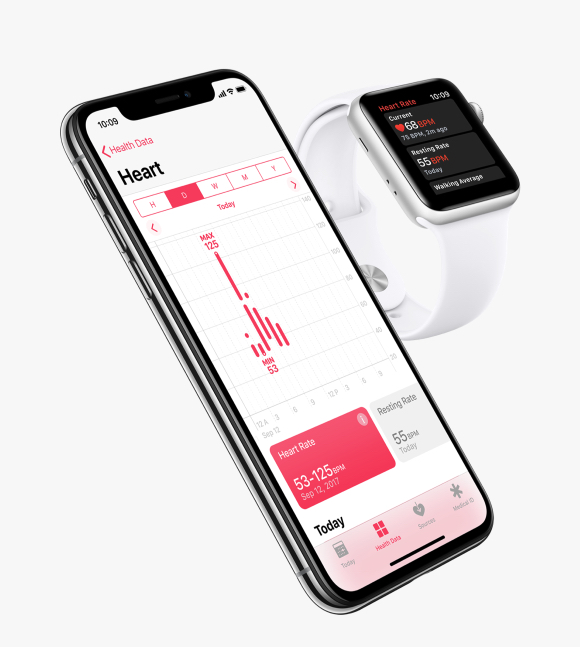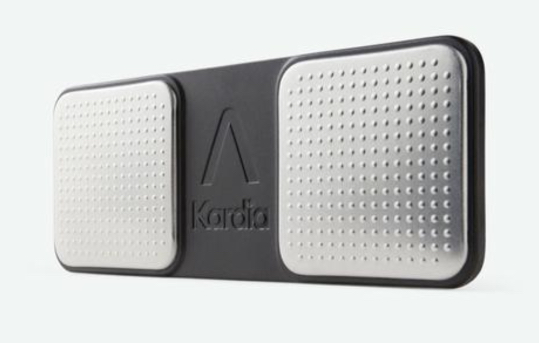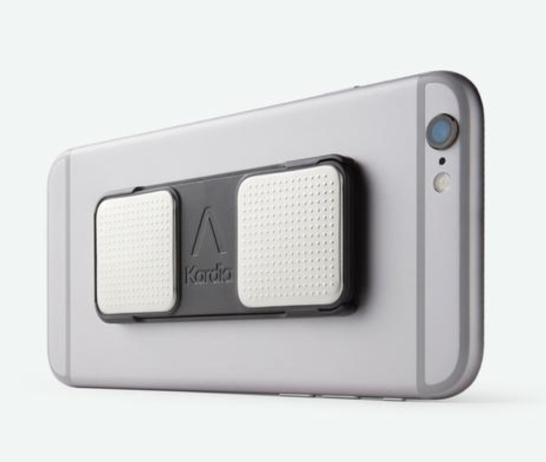
After all that turkey and Christmas pudding, spare a thought for the old ticker. Your New Year’s resolution could be to embrace electronic wearables to monitor your health and wellbeing. These days a watch isn’t just for telling the time, in fact that’s the least of its talents.
I’ve written before about my reliance on the Apple Watch for health monitoring. It’s not just daily steps, general exercise and floors climbed that I’m thinking about. It is the far more important role of wearables in the field of medical monitoring and diagnostics. We are right at the beginning of these exciting developments and I expect great things from wearables, including the Apple Watch, in the next few years.

Things are moving rapidly even now. Last month Apple announced a heart study in conjunction with Stanford University aimed at detecting irregular heart rhythms using the Watch. It’s a study I will definitely take part in when it is released to participants outside the USA. I have been involved with a similar project at the University of California San Francisco for the past two years (see below). This is already proving invaluable in adding to the general knowledge base and creating algorithms which can automatically detect abnormalities and alert participants in the programme.
Arrythmia
Pulse monitoring has been very important for me because, as I’ve written previously, I have suffered from arrhythmia off and on for many years. I’ve had treatment¹ and, fortunately, things have settled down over the past five years. The problem is that it isn’t always easy to be aware of arrhythmia and I am sure that thousands of people have irregularities without knowing it. A racing heart beat for no reason is pretty obvious, but lesser symptoms can go undetected and can have serious consequences. One of the primary health risks with arrhythmia is stroke caused by clotting when the heart returns to normal sinus rhythm. I’m no doctor, I stress, but like anyone who has a chronic issue I’ve learned a lot over the years.

The only foolproof way to check what’s happening is to take an ECG and up to now that hasn’t been at all straightforward. The problem is that arrhythmias are mostly intermittent. Even if you notice something is wrong, by the time you’ve arranged to see a doctor and get to a cumbersome ECG machine it is more than likely everything will be back to normal.
When I first noticed my arrhythmia I didn’t know what it was. I thought it was simply what the Victorians dismissed as “palpitations”. After the original referral I was back and forth to the cardiologist over a couple of months but nothing could be conclusively diagnosed. The ECG was always showing normal — probably the reverse of the so-called “white coat syndrome” when you have your blood pressure checked. So, finally, I was told to jump in a taxi the next time had an episode and drop by for an instant ECG. It was only after doing that I found out the real cause of the problem.
Wouldn’t it be nice?
Wouldn’t it be nice if we could have a quick way of generating an ECG at the time of an episode, ideally at home and without all those pads and wires? Now, we can and I’m optimistic that it will transform diagnosis and monitoring.
For the past two years I’ve been taking part in the UCSF Health eHeart Study together with some 145,000 arrhythmia sufferers throughout the world. The statistics from my watch are shared with the study every day. Between us we have clocked up 15 billion steps already and the accumulated data is going a long way to increase knowledge of arrhythmia. I’ve chatted about it with my cardiologist on a number of occasions and I know from him that the increasing use of wearable monitors — largely, it has to be said, in the form of the Apple Watch — is transforming detection and treatment.


Then, a month ago I paid a routine visit to my general practitioner and we got to discussing the Apple Watch. He asked if I knew about the AliveCor Kardia devices which record medical-grade ECGs as often as you wish. I hadn’t, but I was soon ordering one from Amazon. For what it is — a small panel measuring 8x3cm with two silver finger sensors — it is expensive at £99. But I was surprised to find that it works reliably and produces what appears to be a reliable ECG on the phone screen. It needs a free iPhone app, of course, but once set up it is simply a matter of placing two forefingers on either pad and then waiting 30 seconds for the ECG to be created. Magic, if ever I’ve seen it.
Note: In the UK we refer to an ECG, electro-cardiogram, and in the USA it is an EKG, electro-kardiogram. Same thing.
The advantage of this, as any arrhythmia suffer can attest, it the ability to record an ECG during an episode. You can’t put a value on that, and AliveCor makes it easy to send your ECG graphs by email to your physician for interpretation. You can even get an independent medical opinion at a cost of £5 if you don’t want to bother your doctor. The system gives an overview based on known algorithms and, so far, all my readings have been said to be normal. I hope to keep it that way. But I am now equipped to take a quick ECG whenever I sense something is amiss and the Kardia has given me a lot of peace of mind.
FDA and NICE approved
Following on from my first exposure to the AliveCor Kardia I read this week that the company’s newest device, a sensor that fits on the Watch band, is the first of its kind to be awarded FDA (US Food and Drugs Administration) certification as an Apple Watch peripheral. It is also approved in the UK by NICE (National Institute for Health and Care Excellence). As I said, things are moving. This device allows ECGs to be taken anywhere at the press of a button on the watch face and is clearly more convenient than the portable pad which I outlined above. It does, however, mean that you can’t use your own watch band and, for me, that’s an inconvenience. I will probably stay with the pad which fits comfortably in the cover flap of the Apple iPhone wallet. Another disadvantage of the band is that the number of pulse measurements is increased to the point where battery life suffers.

Neither the AliveCor Kardia (£99) nor the Kardia Band EKG meter (£199) is cheap, but for those who have known heart rhythm problems the real cost is peanuts. Whichever monitor you choose, to get best use out of it you need to subscribe to AliveCor’s monitoring service (£99 a year). This includes the SmartRhythm service which samples real-time and historical data to predict what is considered acceptable. The app will tell the user to take an ECG if it detects abnormality.
For the first time, thanks to wearables, the patient is now being put in the driving seat. Apple is hoping to extent the functions of the Watch to detection of hypertension and hypotension and, in time, to enable it to perform other diagnostic procedures such as, possibly, real-time blood sugar level detection. We’ve come a long way, but we are now on the cusp of a major breakthrough in health monitoring which, ultimately, will help prevent millions of deaths.
Implications
There are long-term implications for health costs, particularly in a country such as Britain which has a free-at-point-of-pain system with no need for insurance claims, part payments or intrusive questioning. Some say it is too lacking in controls and results in abuse, particularly from health tourists.
However, the snag here is that there is sure to be increasing demand for the health service (read taxpayer) to pay for preventative medicine, under category which we could place the Kardia and similar devices. How long before there is a clamour for the NHS to pay for devices such as the Kardia, even, supply a free Apple Watche or iPhone? It’s a slippery path to ruin for any country.
On the other hand, money spent on prevention and detection can have long-term benefits in reducing the need for invasive procedures and hospital in-care. If wearables such as the Apple Watch can provide advance warning of looming medical problems, the opportunities to transfer costs from emergency treatment to active prevention should be grasped.
Below: The Kardia Apple Watch band works in the same way as the stand-alone Kardia Mobile EKG and you can take an ECG reading by pressing a button. It does eat into battery life, however, and you are stuck with the one wrist band
Meantime, what of the traditional watch? My poor old IWC Pilot Chronograph remains unused after nearly three years. It does nothing but tell the time, however elegantly. It certainly doesn’t offer to save my life. I am now so reliant on the Apple Watch that I cannot envisage wearing the IWC again. Pity, but it now makes sense to stick with the Apple Watch and its ever-increasing range of health benefits.
Important: I have written this from the point of view of the layman with a diagnosed condition. While the Kardia device is invaluable for me, it isn’t the basis of self-diagnosis. If you feel you do have a problem, particularly if there are obvious symptoms of irregular heart beat or palpitations — or raised pulse levels for no obvious reason — you should seek medical advice. Once the problem has been established, if there is one, it’s time to think of using monitoring to keep any chronic conditions in check.
More insight
- How Apple Watch Saved My Life
- Apple and Stanford team up to spot atrial fibrillation
- Apple Watch in heart study
- Apple releases heart study app
- How Apple Watch saved a man’s life
- How to set up Medical ID on your iPhone
- Wearables — Apple Watch has won
- Apple adding ECG monitoring to Watch
_____________
- Subscribe to Macfilos for free updates on articles as they are published
- Want to make a comment on this article but having problems?
________________

I love my watch series 2, it is an excellent bit of kit and has done just about every mile of my marathon training for Brighton 2018. I have mixed views about running apps, but regularly flick through my statistics in the iPhone health app. It is a wonder to behold.
Excellent article Mike, I am tempted to take a look at the watches now.
One of the things that interests me, is their accuracy. Despite putting a few relevant settings into our iPhones, SWMBO and myself walk a lot, and sometimes we remember to look at the Health app and note that one of us has walked a lot further than the other, despite us walking together…?
Frankly, I am surprised that I don’t have heart issues, though I think I have finally ceased, I smoked quite heavily for 45 years, but feel fit as the proverbial f.
On the political note, I take on board what you were saying about the NHS. If the USA had the same system that we have here, I suspect that we would not be discussing this great technology. These devices are being developed precisely because big Pharma and the allopathic medical brigade are both expensive and avaricious, and Americans are fighting back with wearable monitors.
By killing Obamacare, Trump has saved America, again! 🙂
Stephen
And a happy New Year to you, Stephen. As it happens, the article might have been a little misleading in that the Kardia works with the iPhone and you don’t specifically need the Watch. But its other health-monitoring features, including constant pulse overview, makes it worthwhile.
I am staying out of politics, as usual. An efficient NHS is a great thing provided they cut out the bloat and stopped health tourism and other abuses (which include permitting ambulance-chasing lawyers to get away with suing the taxpayer for exorbitant damages over minor infractions). It was a mistake to allow lawyers to advertise their dubious wares. We are rapidly following the USA in promoting the blame culture.
The NHS is being killed by bureaucrats, and non-essential workers. Alongside the health tourism, and ambulance chasing lawyers issues. It needs stripping back to essential services, and specialist clinics without the non-medical brigade asset stripping it of millions in wages, pensions and other payments that are not essential.